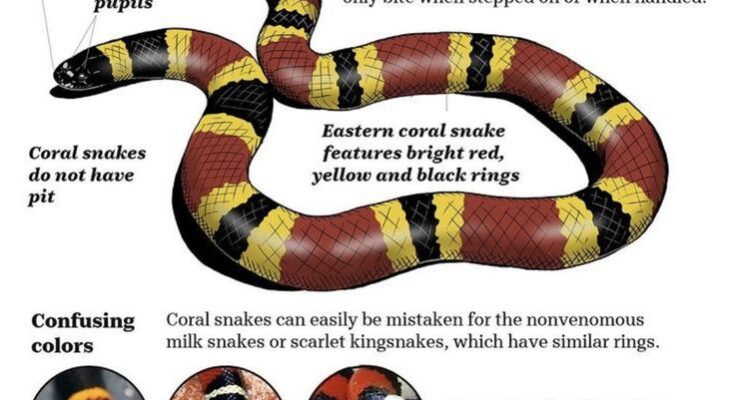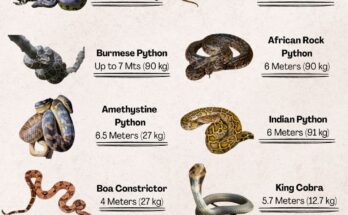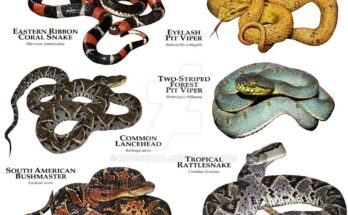How to Identify a Coral Snake: A Detailed Guide
Coral snakes are among the most striking and potentially dangerous snakes found in parts of the United States, including the southeastern and southwestern regions. Their vivid coloration and reclusive nature make them both fascinating and challenging to identify. This comprehensive guide, based on the detailed illustration provided, offers an in-depth look at the Eastern Coral Snake’s features, behavior, and how to distinguish it from similar non-venomous species like the milk snake and scarlet kingsnake. Whether you’re an outdoor enthusiast, a hiker, or simply curious about wildlife, this information will help you stay safe and informed.

Distinctive Features of the Eastern Coral Snake
The Eastern Coral Snake (Micrurus fulvius) is easily recognized by its bold pattern of bright red, yellow, and black rings that encircle its body. These rings are of consistent width and follow a specific sequence: black, yellow, red, yellow, creating a visually stunning contrast. The snake’s head is small and blunt, featuring a black snout with a nostril and round eye pupils, lacking the heat-sensing pits found in pit vipers. Coral snakes typically grow to 20-30 inches in length, though some may reach up to 40 inches. Their smooth scales and lack of a rattle further differentiate them from other venomous snakes. This species is part of the Elapidae family, known for potent neurotoxic venom, making accurate identification crucial.
Behavior and Habitat
Coral snakes are highly reclusive, spending most of their time underground in burrows, under leaf litter, or beneath logs and debris. They prefer habitats such as pine flatwoods, hardwood hammocks, and sandy areas, often in the southeastern states like Florida, Georgia, and the Carolinas. Due to their secretive nature, encounters with humans are rare. They are not aggressive and will only bite when stepped on or handled, relying on their venom as a last resort. Their bite delivers a neurotoxin that can cause severe symptoms, including respiratory failure, so immediate medical attention is essential if bitten. These snakes are active primarily during warm months, emerging at dusk or night to hunt small prey like other snakes, lizards, and amphibians.
Confusing Colors: Distinguishing from Mimics
Coral snakes are often confused with non-venomous milk snakes (Lampropeltis triangulum) and scarlet kingsnakes (Lampropeltis elapsoides), which share similar ringed patterns. The key to differentiation lies in the color sequence and an old rhyme: “Red and yellow, kill a fellow; red and black, friend of Jack.” For the Eastern Coral Snake, the red rings are always adjacent to yellow rings, signaling danger. In contrast, milk snakes and scarlet kingsnakes have red rings touching black rings, indicating they are harmless. The image highlights these differences with close-up views: the Eastern Coral Snake’s red-yellow-black pattern, the milk snake’s red-black-white sequence, and the scarlet kingsnake’s similar non-venomous mimicry. Additionally, coral snakes lack the broader head and facial pits of pit vipers, aiding in identification.
Safety and Observation Tips
Encountering a coral snake requires caution due to its venomous bite, though its reclusive behavior reduces the likelihood of interaction. If you spot one, avoid approaching or attempting to handle it. Wear sturdy boots and watch your step in snake-prone areas, especially during warmer months from April to October. The round pupils and absence of pits are critical identifiers when comparing it to venomous pit vipers like rattlesnakes. For photographers or nature observers, use a zoom lens from a safe distance to capture its beauty without risk. If you suspect a bite, seek emergency medical help immediately, as antivenom is available but time-sensitive.
Appreciating Coral Snakes in the Wild
Despite their danger, coral snakes play a vital role in their ecosystems by controlling populations of other reptiles and small animals. Their bright colors serve as a warning to predators, a phenomenon known as aposematism. As of July 05, 2025, conservation efforts continue to monitor their populations, which face threats from habitat loss and road mortality. This guide, inspired by the USA TODAY illustration, equips you with the knowledge to identify and respect these elusive creatures. Whether you’re exploring the forests of the Southeast or learning from afar, understanding coral snakes enhances your appreciation of nature’s diversity.
Note: Always prioritize safety and consult local wildlife experts or medical professionals for guidance in snake-prone areas.



